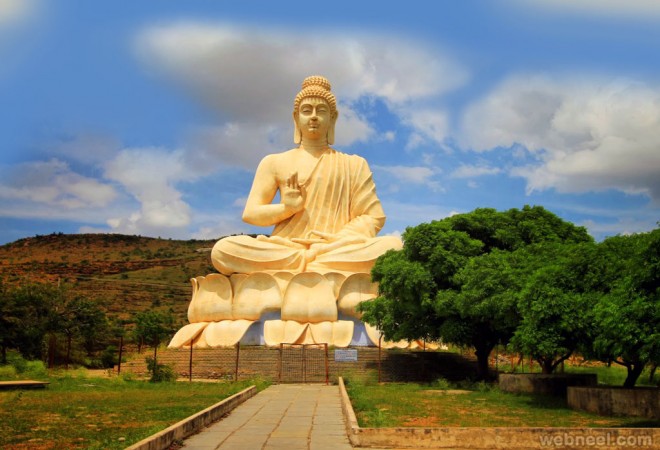Buddhism in India

Buddhism is a religion and philosophy encompassing a variety of traditions, beliefs, and practices, largely based on teachings attributed to Siddhartha Gautama.
In some classifications Vajrayana—as practiced mainly in Tibet and Mongolia, and adjacent parts commonly known as the ” Buddha – the awakened one”. Buddhism originated in India during the sixth century B.C.E., and its founding figure, Buddha, was a contemporary of Confucius in China and the early Greek philosophers, antedating Jesus by 500 years and Muhammad by a millennium. Buddhism was rooted in early Indian cosmology and adapted concepts such as dharma, “duty” in the Upanishads, and the “fundamental law of the universe” in Buddhism, to its own ends. By the beginning of the first millennium C.E., however, the influence of Buddhism waned in its South Asian homeland as it began to spread from India to East and Southeast Asia, where it gained many followers and became a potent cultural, social, and even political force.
The northeastern states of eight sisters, currently represented by Assam, Arunachal Pradesh, Manipur, Nagaland, Meghalaya, Mizoram, Tripura, and Sikkim occupy an important niche in the culture of India. Like the western frontier of India was linked with western and central Asia, the eastern frontier touching Tibet, China, and south-east Asia has been linked with the eastern part of the world. The area is the home of a number of people believing in Buddhism.
In the West, a new name is given to Buddhism— the religion of freedom and reason. Since Buddhists do not depend on gods for their salvation but are encouraged to purify and develop their own minds. Buddhism is also described as a ‘do it yourself religion. Obviously, Buddhism is a religion for spiritually mature people. In the West, they cannot find these two aspects of any other religion but only in Buddhism. The Buddha wanted to release us from religious slavery by introducing a rational religion for us to practice by giving due credit to our human intelligence and by maintaining our human dignity. With Buddhism, we can cultivate our human values without any ex-communication, religious law, and religious punishments. The Buddha divided the two extremes of life—addicted to pleasure and self-mortification. He chose the middle path—the noble eightfold path of right view, right purpose, right speech, right action, right livelihood, right effort, right-mindedness, and right absorption of the mind.
Becoming the “Buddha”: The Way of Meditation According to tradition, Siddhartha seated himself at the foot of a tree, which has since been called the Bodhi Tree, the tree of enlightenment. He vowed to sit beneath that tree until he had attained deep insight into suffering. As he sat through the night, a profound stillness settled upon his mind, like that of a lake on a windless day. This stillness enabled him to see ever more deeply and clearly into the cycle of grasping, clinging, and egotism found at the root of suffering. The demon Mara rose to tempt him and to attack him with arrows of passion. Desire, fear, pride, and thirst rose to challenge his clear concentration of mind. But Siddhartha placed his hand on the earth, calling earth itself to witness his firm resolve. When the morning star appeared, Siddhartha Gautama became the Buddha, literally the “Awakened One.” He had woken up to the nature of the changing world and the causes of suffering. This state of awakening was also called nirvana, literally the “blowing out” of the fires of ego-centered attachment which are the source of suffering.
Siddhartha is called Shakyamuni Buddha, the “Sage of the Shakya clan” to make clear that this awakening is not uniquely his. Over time, there have been other individuals who have awakened to the truth and gained enlightenment, thereby becoming Buddhas. Among the most well-known and widely venerated are Amitabha (Amida) Buddha, Vairochana Buddha, and Bhaishajya-guru (better known as the Medicine Buddha). Indeed, sometimes Buddhas are depicted by the thousands, for the “Buddha nature” is the true awakened nature of all beings.
It is said that, out of great compassion, the newly enlightened Shakyamuni Buddha set out to show others the path he had followed so they might set foot on that path as well. After his awakening, the Buddha taught in the cities and villages of North India for some forty-five years.
The Dharma: The Teachings of the Buddha
The Buddha’s sermons and teachings pointed toward the true nature of the universe, which is known within Buddhism as the Dharma. He gave his first sermon on the outskirts of the city of Varanasi at a deer park called Sarnath. This first sermon presents an overview of suffering and the way out of suffering. It is called the “Four Noble Truths.”
1. Life involves suffering, dukkha
2. Suffering is caused by desire and grasping
3. There is a way out of suffering
4. The way is the “Noble Eightfold Path.”
Global Buddhism
The Dalai Lama is undoubtedly the most famous face of contemporary Buddhism and is considered a spiritual leader among Buddhists from many different schools and traditions. Tenzin Gyatso has traveled widely as a teacher, scholar, and statesman promoting peace and nonviolence to a world audience. The annexation of Tibet by the Chinese in the 1950s and the subsequent establishment of the Tibetan Government in exile in Dharamsala, India have inspired Free Tibet movements around the world. Though the Chinese dispute this version of history, global admiration and support of the Dalai Lama and his message of peaceful coexistence is widespread and pervasive, leading many to associate Buddhism with a universal and uncompromising understanding of nonviolence. Other well-known Buddhists representing a nonviolent understanding of Buddhism are the Vietnamese monk Thich Nhát Hanh who protested against the Vietnam War and continues to promote peaceful coexistence through his Center in France known as Plum Village, and the American Buddhist nun Pema Chödrön who teaches about paths to individual spiritual enlightenment.
Suggested Read: Indian Religions






